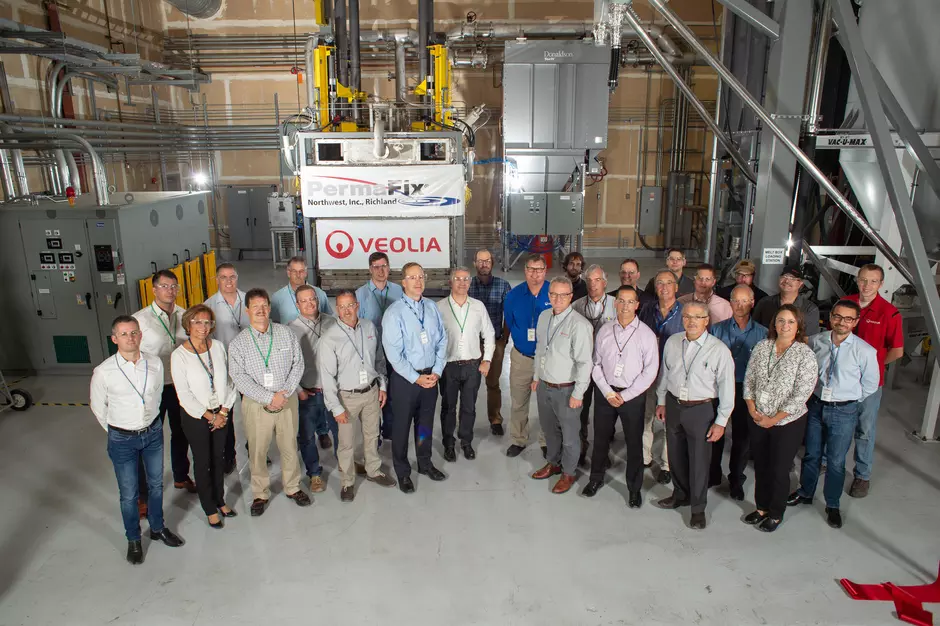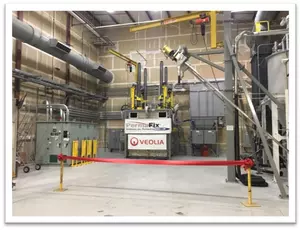The INL project is contracted through VNS Federal Services LLC, which has operations across five DOE sites. The contract with the INL to treat the sodium-contaminated wastes follows successful engineering scale demonstrations of the patented GeoMelt® technology earlier in the year. The goal of the engineering scale testing was to confirm the ability of the GeoMelt® technology to create a safer treatment approach that lowers the lifecyle cost to disposition radioactive contaminated reactive metal waste streams resulting from decommissioning sodium-cooled reactors. The demonstration, supported by glass formulation and crucible testing, consisted of a series of bench scale ICV™ melts that processed elemental sodium into a stable non-reactive form.
The Perma-Fix facility is a Resource Conservation and Recovery Act-licensed facility owned by Perma-Fix Environmental Services, Inc. The design and installation of the system took nine months to complete and was funded by the two corporations under a cooperation agreement.
This is the third GeoMelt® facility in operation, following the 2003 opening of the Daiei Kankyo hazardous waste processing system in Iga City, Japan, and the 2016 opening of the UK Nuclear National Laboratory’s Central Laboratory on the Sellafield site to treat low and intermediate level wastes. A fourth facility was announced in June under a joint development partnership with EDF, the world’s largest nuclear operator, to treat low and intermediate level wastes from its fleet of nuclear power plants. In 2017, Veolia Nuclear Solutions was additionally awarded a unique nationwide license by the U.S. Environmental Protection Agency (EPA) to operate its GeoMelt® ICV™ system as a thermal alternative disposal method to destroy and delist as a hazard Polychlorinated Biphenyls (PCBs) in contaminated soil, waste, and debris. The award by the EPA was made following confirmation that the GeoMelt system achieved a final destruction and removal efficiency of at least 99.9999 percent.
The string of international successes confirms the growing recognition and adoption by industry of the GeoMelt® technology to lower the lifecycle treatment costs of the most challenging environmental and hazardous waste challenges around the globe. In fact, GeoMelt® has been treating nuclear and hazardous waste since the 1990s, producing more than 26,000 metric tons of glass for disposal in the U.S., UK, Australia, Japan and other countries.
The GeoMelt® technology converts radioactive, hazardous, and mixed wastes into a volume-reduced robust, obsidian-like inert glass form for safe disposal. Unlike encapsulation processes such as cementation or polymers, where the wastes retain their identity and can be exposed during mechanical crushing or erosion, vitrification results in a chemical bonding at the molecular level of the wastes that have been dissolved into the liquified glass formers. This creates an insoluble leach-resistant product that remains stable and prevents dispersion of the waste to the surrounding environment over geological durations. Additionally, many hazardous materials are destroyed or converted into non-hazardous classifications (e.g. PCBs, asbestos, sodium metal). This is accomplished by the thermal or chemical interaction with glass formers during the pyrolysis and vitrification phases of the GeoMelt® process. As a result, the GeoMelt® vitrification process offers significant advantages over competing technologies for radioactive, hazardous and mixed waste treatment and site remediation.

The objective of the INL contract, awarded in September, is to demonstrate at full-scale the treatment capabilities of the GeoMelt® technology by chemically converting the reactive metals to an inert oxide thereby delisting the sodium hazard in the waste and immobilizing and stabilizing the radioactive contamination. Under the agreement, Veolia Nuclear Solutions will treat radioactive contaminated sodium wastes shipped in Fermi Drums that were received at INL in the 1980s. They were contaminated with low-level radioactively contaminated elemental sodium from the Enrico Fermi Atomic Power Plant and have been maintained at INL for decades. However, as a credit to the partnership with INL, the maturity of the technology and an aggressive construction schedule, the team successfully completed the first melt of 55 drums of radioactive contaminated sodium wastes on December 20, 2018.


